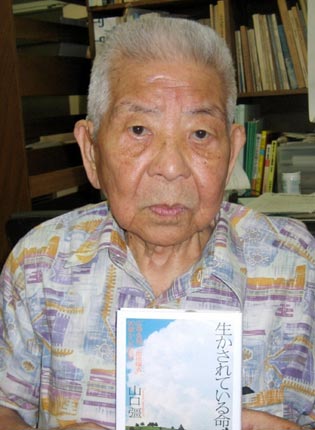Tsutomu Yamaguchi: Survivor of both the Hiroshima and Nagasaki atomic bomb blasts

Tsutomu Yamaguchi was the only officially recognised survivor of both the Hiroshima and Nagasaki atomic bomb blasts at the end of the Second World War. Yamaguchi, however, was only formally acknowledged as an Eniijuu hibakusha (double bomb sufferer) by both the Nagasaki and Hiroshima authorities in March 2009.
On 6 August 1945, Yamaguchi, a young engineer with the shipbuilder Mitsubishi Heavy Industries, was in Hiroshima at the end of a short-term secondment with two colleagues. He recalled hearing engine noise in the skies above, but thought nothing of it as this was commonplace owing to Hiroshima's importance as an industrial city and military base. In fact, what he heard were the engines of the US B-29 bomber, the Enola Gay, which was about to drop the first atomic bomb on the city. Seconds after getting off a tram he saw a flash of light and was knocked to the ground by the force of the bomb, and passed out as it detonated 600m above Hiroshima at just after 8.15am. He later recalled seeing a huge mushroom-shaped pillar of fire rising up high into the sky.
The "Little Boy" bomb, a reference to former President Roosevelt, was a 13 kiloton uranium atomic bomb which contained devastated an area of five square miles. Around 140,000 of Hiroshima's 350,000 population perished instantly and in the aftermath thousands more suffered burns, Yamaguchi among them. Though less than two miles from Ground Zero, he suffered only serious burns to his upper body and a perforated eardrum.
Yamaguchi spent the night in the city in an air-raid shelter with people dying and screaming out with pain all around him. The following day, Yamaguchi and his two colleagues navigated through the piles of burnt and dying bodies in order to catch a train the 180 miles back to their home, Nagasaki which, like Hiroshima, was an important industrial and military base. Upon his return and with his burns swathed in bandages, Yamaguchi reported for work on 9 August. His boss and co-workers listened with incredulity as he described how a single bomb had destroyed the city.
At 11.02am, and once again less than two miles from the centre, Yamaguchi saw a familiar flash of light. The US Airforce had dropped another nuclear device, "Fat Man", named after Winston Churchill. This time a 25-kiloton plutonium bomb exploded above Nagasaki, throwing Yamaguchi to the ground. As Nagasaki is surrounded by mountains the level of destruction was more confined; nearly 74,000 were killed and a similar number injured. Yamaguchi, his wife and baby son survived and spent the following week in a shelter near what was left of their home. On 14 August, Emperor Hirohito announced Japan's surrender.
Tsutomu Yamaguchi was born in Nagasaki on 14 March 1916. He studied engineering and joined Mitsubishi Heavy Industries as a draftsman designing oil tankers at their shipyards in Nagasaki. After the war he worked for the US occupation authorities as a translator, became a school teacher and returned to Mitsubishi Heavy Industries before retirement.
Yamaguchi's two hellish experiences and their effect upon his family were considerable. As well as almost total deafness in one ear, his skin wounds were bandaged for 12 years, and his wife was poisoned from the radioactive fall-out. She died in 2008, aged 88, of kidney and liver cancer. Their son, exposed to the Nagasaki radiation at six months old, died in 2005, aged 59.
Much of this turned Yamaguchi into a passionate anti-nuclear weapons campaigner but he never expressed any anti-Americanism. He gave talks about his experiences and often expressed the hope that such weapons would be abolished: "I can't understand why the world cannot understand the agony of the nuclear bombs. How can they keep developing these weapons?" He wrote books and appeared in a documentary, Nijuuhibaku, [Twice Bombed, Twice Survived], which was screened at the Uniated Nations in New York in 2006, when he also addressed the UN, urging them to abolish nuclear weapons.
As a registered survivor of the Nagasaki bombing, Yamaguchi owned a pale violet copy of the Atomic Bomb Victim Health Handbook since 1957, which entitled him to monthly allowances, free medical check-ups and funeral costs. More than 260,000 others were similarly covered. In March 2009, Yamaguchi was finally certified by the Japanese government, and so acknowledged as having Eniijuu hibakusha status. "My double radiation exposure is now an official government record," he said. "It can tell the younger generation the horrifying history of the atomic bombings even after I die."
Yamaguchi, who died of stomach cancer, viewed his ordeals as a cruel twist of fate, a "path planted by God". "It was my destiny that I experienced this twice and I am still alive to convey what happened," he said.
Martin Childs
Tsutomu Yamaguchi, engineer and atomic bomb survivor: born Nagasaki 16 March 1916; married (wife died 2008; one son deceased, one daughter), died Nagasaki 4 January 2010.
Join our commenting forum
Join thought-provoking conversations, follow other Independent readers and see their replies
Comments